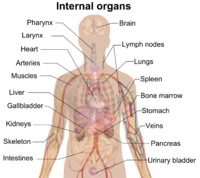
Photo from wikipedia
With 10 talks, the “Multicellular Interactions: Tissue Regeneration and Mechanisms of Disease” Minisymposium covered a variety of postdevelopmental themes, including inflammation, epithelial differentiation, regeneration, and cancer. The presentations were selected… Click to show full abstract
With 10 talks, the “Multicellular Interactions: Tissue Regeneration and Mechanisms of Disease” Minisymposium covered a variety of postdevelopmental themes, including inflammation, epithelial differentiation, regeneration, and cancer. The presentations were selected by Elly Tanaka (IMP Vienna), Danelle Devenport (Princeton University), Matthew Tyska (Vanderbilt University), and Philipp Niethammer (Memorial Sloan Kettering Cancer Center). Philipp Niethammer chaired the session and showed unpublished data supporting an essential role of tissue damage signaling for leukocyte recruitment to infection sites in zebrafish larvae. Next, Stephanie Ellis (Rockefeller University) discussed different cell competition strategies for eliminating less-fit “loser” cells from developing skin: Whereas in proliferating monolayers this occurs through apoptosis, she suggested that in stratifying skin it mainly occurs through cell differentiation. Miranda Hunter (University of Toronto) then explained how oxidative stress at wound sites promotes wound healing in fruit fly embryos through oxidation of Src kinase, which coordinates the redistribution of cytoskeleton and cell junctions. Jui-Hisa Weng (Harvard Medical School) suggested an unconventional mechanism for the anti-inflammatory actions of colchicine, which is a frequently prescribed gout medication. She presented experiments suggesting that colchicine induces expression of a cytokine in the liver to mediate the therapeutic effects of this drug. Daniel T. Grimes (Princeton University) discussed data demonstrating that motile cilia are important during growth phases to maintain a straight spine in zebrafish. Accordingly, several zebrafish mutants of cilia motility exhibited juvenile-onset severe spinal curves closely modeling the prevalent human condition idiopathic scoliosis (Grimes et al., 2016). Takuji Sugiura (IMP Vienna) summarized his work on the Axolotl MARCKS-like protein (AxMLP) that acts as an extracellular trigger for cell proliferation in the regenerating salamander (Sugiura et al., 2016). He presented unpublished data suggesting an important role for extracellular vesicles in AxMLP secretion. Amelie Raz (MIT/Whitehead) compared regenerative patterning in an early-branching Bilateria, the acoel Hofstenia miamia, with other bilateral, regenerative mechanisms, suggesting that muscle plays an ancient and conserved role in regenerative patterning, dating back to the dawn of the Bilateria more than 550 million years ago (Raz et al., 2017). Cory Simpson (University of Pennsylvania) developed a three-dimensional model of human skin to study how autophagy contributes to epidermal morphogenesis using confocal microscopy. He suggested a role for a mitophagy receptor in initiating the breakdown of mitochondria in the upper layers of epidermal keratinocytes as they undergo terminal differentiation to form the cutaneous barrier. Vanesa Silvestri (Johns Hopkins University) detailed a microfluidics approach to model a morphologically realistic vasculature along with a three-dimensional, organotypic culture of mammary gland tumors to quantify tumor–vessel interactions under in vivo– like conditions. Last but not least, Duygu Ozpolat (Marine Biology Laboratory, Woods Hole) presented a lineage-tracing study in segmented worm embryos (Platynereis dumerilii) investigating the embryonic origins of the mesodermal growth zone stem cells, the trunk mesoderm, and the germline (Özpolat et al., 2017).
Journal Title: Molecular Biology of the Cell
Year Published: 2018
Link to full text (if available)
Share on Social Media: Sign Up to like & get
recommendations!